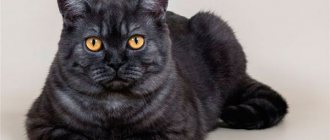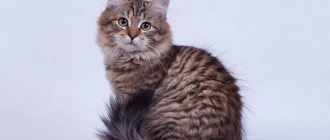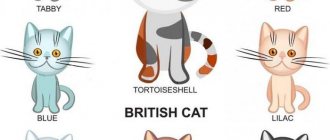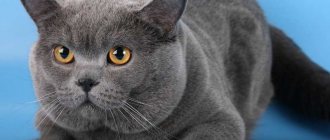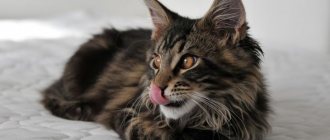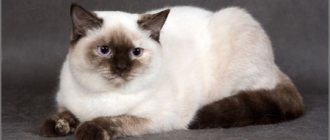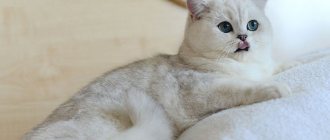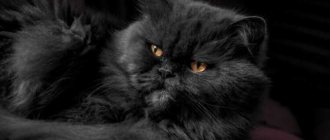Cats are adored for their amazing colors. The “black smoke” color of the cat’s coat is interesting for its unusual nature. The English name sounds like black smoke. Smoky shades are common among many breeds. According to the classification of colors accepted throughout the world, there are several types of smokes: black, tortoiseshell, cream, blue, chocolate, red, lilac.
The haze effect appears due to the pronounced contrast in the color of each hair. The tip is the most saturated shade, and the base is much paler or white.
Rare colors of British cats
Today, relatively new and rare uniform colors stand out - cinnamon and fawn.
Dark colors of British cats are dominant, so light-colored kittens are rarely born. Cinnamon is a very rare and desirable color, its name comes from the English cinnamon, which translates as cinnamon. The color is similar to lightened chocolate. The gene for this color, discovered 50 years ago, is recessive, so cinnamon kittens are born quite rarely.
Fawn is an even rarer color, which is a bleached cinnamon. It was recognized quite recently, in 2006, and is of particular interest to breeders, as it makes it possible to develop new lightened colors.
Fawn-like kittens, i.e., fauns, and cinnamon cinnamon kittens are classified as cream and blue at birth. To identify a rare color, a DNA examination is carried out, which confirms that the animal belongs to a rare color.
Tortoiseshells
Tortoiseshell cats are a favorite among breeders. From these mothers you can get a wide variety of offspring. Their unique color, also called torti, combines two groups of colors at once - red and black, and this is possible only in females. Tortoiseshell cats can only be born as a result of a genetic anomaly - mosaicism. Such animals are infertile and have the XXY genotype.
The tortoiseshell color consists of black and red spots evenly distributed throughout the body (or derivatives of these colors, for example, blue and cream, chocolate and cream, lilac and cream, etc.).
There are a huge number of British tortoiseshell species:
- Classic turtle (black-red, chocolate-red, lilac-cream, fawn-cream, cinnamon-red, lilac-cream).
- Smoky turtle (black and red smoky, chocolate red smoky, etc.).
- Tortoiseshell tabby, or torby (black and red tabby, chocolate red tabby, etc.).
- Tortoiseshell color point, or tortie (tortie point - black tortoiseshell, blue cream point - blue tortoiseshell, etc.).
- Bicolor tortoiseshells or calicos (black and red bicolor tortoiseshell, etc.).
- Bicolor tabby tortoiseshell, or torbico (marbled, striped, spotted bicolor tortoiseshell).
A tortoiseshell kitten can be born from parents of different color groups, for example, the mother is red and the father is black.
Solid colors
Solid colored cats have evenly colored fur throughout the body, face, tail and limbs. The shade of the nose and paw pads also matches. The appearance of spots, highlights, and stripes is a sign of defectiveness.
Despite the apparent simplicity of this color, it is the result of the painstaking work of specialists. It is the uniform solid color that is the first and most important criterion for assessing whether an animal belongs to an elite breed (Nibelungs, Chartreuses, Bombays).
The most difficult thing to achieve is a solid color with red and cream pigment. Therefore, a red fur coat of a solid color may still have some semblance of a pattern or stripes.
A fairly common shade is a solid black shade. Gone are the days when it was believed that a black cat would bring bad luck. Today, pets with a coat color like the darkest night are among the most sought after. There is even a breed (Bombay cats) whose fur is exclusively black.
Cream shades are also difficult to dilute. The color of the coat should not be faded, but moderately saturated, and the shade of the nose and paw pads should match the tone of the fur coat as closely as possible. A lighter or white undercoat is not acceptable. Solid cream cats have copper or orange eyes and pink paw pads and noses. Among the most valuable breeds with a complex solid shade are the Cinnamon and the Briton fawn, the Lilac Briton.
The tortoiseshell color is considered quite valuable and complex. It can include a variety of shades of red and black. At the same time, black is always clearly visible and clearly defined, and red color implies a slight blurriness, tabby. For the tortoiseshell color, the presence of stripes and white spots is also acceptable.
Blue is a solid light gray color. It is interesting that genetically he did not appear from white (this does not exist unless we are talking about mutations), but from black. It must be uniform, without impurities. As a rule, such animals have expressive green or orange eyes. You can also recognize them by their bluish-gray nose and paw pads.
There is also a creamy-blue tortoiseshell color, which implies a chaotic arrangement of cream and blue spots along the animal’s body.
The price may be determined by the following factors
The most popular cats are those with black fur coats.
Of particular value are black cats with a silver color and cats with a smoky color.
- Maine Coon age. The highest price is asked for babies 2-5 months old. They are more likely to adapt to changed living conditions and to changes in owners than adult animals.
- Despite the same color, the cost of cats is higher than that of females. They look much more powerful and make a greater impression. There is more playfulness and enthusiasm in their behavior.
- If the purity of the breed is not of great importance to the buyer, then you can purchase a pet with minor flaws in appearance (Pet cat); if the purchase of a cat presupposes its further participation in exhibitions, then it is necessary to take a breed cat (color defects); the most expensive will be a show-class representative; his data must meet all points of the purebred standard.
If you voice specific figures, then a pet will cost approximately 10 thousand rubles in a nursery. Breed from 20 thousand to 25 thousand rubles. For show class you will have to pay at least 50 thousand, and maybe even all 70 thousand rubles.
You can try to buy a purebred kitten online or on the market for much less money. Such a purchase can cost only a few thousand rubles. But no one can guarantee that this cub was born from real Maine Coons. If you want to engage in purebred breeding or are purchasing an animal to participate in competitions, then remember “the miser pays twice.” By buying an animal from dubious hands, you are not only throwing money away, but also wasting time and money on maintaining a kitten of an unknown breed.
In addition to the varieties of black Maine Coon, there are also types that are popular and in demand: Red marbled, different types of tabby, Blue solid with white, Tiffani.
When breeding and raising a Maine Coon, learn more about the conditions of its maintenance, nutrition, and care. What kind of physical activity do they need, can they be trained. Find out what character traits representatives of this breed have.
Useful materials:
- Cutaneous horn General description of the disease Cutaneous horn on the forehead or face (ICD 10 code - L57.0) -...
- Itching and odorless discharge Main causesBefore considering the factors that provoke the appearance of discharge that has a sour odor, it is necessary to immediately note...
- Normal temperature in animals Normal temperature in different types of animals Veterinary services Day hospital for animals Veterinary certificates Vaccination…
- Discharge in women What kind of discharge between menstruation is considered normal? Female discharge normally consists of mucus from the cervical canal, dead...
Colorpoint: a variety of beautiful colors
Translated from English, the name of this group means “colored tip.” Indeed, the animal has a light body, and the tips of its ears, paws and muzzle have a darker shade. Individuals of this group can be identified by darkened areas on lighter fur. Siamese and Himalayan cats are considered typical representatives of this group.
To understand the characteristics of the color, it is useful to know the principle by which these very names are constructed: primary color + pattern (if any) + the word “point”. For example, seal point (brown on light), tabby point.
Some cat breeds have their own colorpoint name. Thus, Persians with a Siamese color are usually designated as Himalayan. Burs have their own line of names. Professionals might simply say lilac, sable chocolate color. However, in relation to this breed there will be not a solid color, but a color point.
British shorthair smoky cat
This is perhaps one of the most famous and beloved breeds in the post-Soviet space. It was officially registered in the 19th century by the British. In the same century, the first exhibition was held, at which power-hungry and proud British cats were presented.
British shorthair cat
Breed Features
In most cases, these are strong and robust cats. They grow to medium or large sizes. The maximum weight of the “British” is 8 kg (males) and 5 kg (females). Cats of this breed grow up to 5 years old.
Table 2. Distinctive features of the British Shorthair cat.
| Cat body part | Breed Features |
| Torso | Strong, big-boned. Muscular. The back is quite massive. The proportions are correct |
| Head | The shape is regular and round. The skull is wide. The muzzle has a round shape. Tall individuals always have convex cheeks. It seems that the cat is constantly smiling |
| Ears | The ears are set wide and low. Rounded at the top, small sizes |
| Eyes | Large, round, orange eyes. Wide set |
| Nose | Short, straight, wide. There is a small indentation in the area where the nose goes from forehead to forehead. |
| Limbs | Strong, short |
| Tail | Thick, fluffy, narrow tip |
| Wool | Medium length, straight, tender, dense. The haze can be purple, blue, chocolate, black, red, cream, tortoiseshell. There should be no drawing. There is a contrast between the undercoat and the tips of the hairs. The first should be as close to white as possible, and the second should be a brighter color |
Character
You don’t need to be fooled by the cat’s cute “face.” His character and external data are absolute opposites. They are independent and proud, these are real aristocrats. They do not tolerate familiarity, they love their owner very much, although they experience separation from him quite easily. They love to play with children and are friends with other pets. They do not tolerate strangers and prefer to wait out their presence in the house in a quiet and secluded place. And, no matter how the guest tries to gain his trust, his aristocratic nature will never break. On the contrary, a persistent person risks being bitten.
"Brits" are friends with other pets
Care and health
British cats are quite healthy. Only occasionally they are bothered by gingivitis (inflammation of the gums) and heart disease. Therefore, veterinarians recommend performing an ultrasound of the heart at least once a year in order to prevent serious illnesses. The “British” are also susceptible to claw fungus and hemophilia (excessive bleeding after surgery and injury). The maximum lifespan of British smokes is 15 years.
"British" dogs require special care. If you don’t comb out their fur every day, then you are guaranteed to have a mess in the house in the form of clumps all over the furniture upholstery and carpets. Therefore, do not be lazy, especially during the molting period. Otherwise, a clean “British” will lick himself so intensively and often that his intestines will be clogged with hairs. Cleaning eyes and ears, as well as trimming claws, are standard procedures for the “British”.
British shorthair kittens
How to feed a British cat correctly?
Health and disease of the British Shorthair cat
The health of the breed is not of serious concern to specialists. But breeders who claim that British Shorthairs are generally not prone to disease are shamelessly disingenuous. Yes, there are no diseases specific to the British cat, however, there are those to which any purebred cat is susceptible, including those caused by genetics, therefore, before allowing animals for breeding, appropriate medical studies must be carried out.
Neighbor Watching
Hypertrophic cardiomyopathy is a thickening of the wall of one of the ventricles (usually the left), which leads to cardiac arrhythmias, heart failure and death. When detected at an early stage and lifelong use of a whole complex of drugs, the development of the disease can be significantly slowed down. Animals with this diagnosis cannot participate in breeding.
Hemophilia B - reduced blood clotting, as a result of which any injury is fraught with serious blood loss or extensive internal hemorrhage. Inbreeding increases the risk of disease. There is no complete treatment; sick animals are given blood transfusions, and to combat anemia and stimulate hematopoiesis, iron supplements, hepatoprotectors, and vitamins B6 and B12 are prescribed. Gene carriers and individuals suffering from hemophilia are excluded from breeding.
What do you allow yourself!
Polycystic kidney disease is the formation of fluid-filled hollow tumors, which disrupts the normal functioning of the excretory system. A typical disease of Persian cats, with which the British suffered from hybridization. At the initial stages there are no noticeable changes in the pet’s behavior, so it is often diagnosed only in an advanced stage. There is no effective therapy. If the cysts are single, they can be removed during surgery, but in case of serious damage, only drug treatment is possible, which will prolong the animal’s life by several months or years.
Gingivitis is an inflammation of the gums that affects the ligaments and bones. Without proper treatment, tooth loss occurs and infection spreads through the bloodstream.
Characteristic
Such a fluffy will definitely get along with the people around him.
Black cats are considered the most obedient, kind and responsive, especially when compared with the characters of individuals of other colors. But this is only true for males. Smoky “emers” are often credited with being unobtrusive, but not shy either. They get along well with people and animals. Each breed has its own personality traits. For example, the Scottish representative knows how to make a show by begging for delicacies. The cat stands on its hind legs and, moving its front legs, looks intently into the eyes.
Personality of a cream British cat
The character of the cream-colored Briton is the same as that of other representatives of this breed.
- This cat cannot be called tame; she prefers solitude. The Briton is an ideal option for an owner who works a lot and is almost never at home.
- She doesn’t come into her arms, and if she doesn’t resist the owner’s expression of affection, she shows with all her appearance that she doesn’t like it.
- Does not support general games, is not active, can sleep 20 hours a day.
- Under certain conditions, the British cat can show aggression, for which it is periodically included in the list of the most evil cat breeds.
Although the influence of coat color on the character of the animal has not been scientifically proven, breeders and owners of solid-cream cats agree that a relationship does exist.
According to reviews, black and black-and-white cats are considered the most aggressive; tortoiseshells have a predominant tendency toward solitude; white cats are more likely to be handled. Cream cats are very curious and show interest in everything new.
The British worthily represent the old English breed, which has a century and a half of selection behind it, the struggle for survival and participation in the genetic line of new representatives - longhaired cats and Scottish Folds.
A cream-colored cat will not go unnoticed
He invariably attracts attention at any exhibitions, and in the house he will be a full member of the family. Whether the cream-colored Briton will become a lucky talisman or remain an expensive and prestigious cat depends only on the owner’s attitude towards his pet.
Features, character and maintenance of British black cats
join the discussion
Share with friends
Classic British cats are recognizable by their rich gray fur. But there are many varieties of this breed, including luxurious black British women, which many consider not only mysterious, but also mystical.
Solid colors
The following solid colors are available:
Black color
This is a rare color, it is difficult to obtain and is considered “capricious”. It often happens that a kitten born black changes its coat color to chocolate as it ages. The pigmentation of the coat, undercoat and skin is rich. In this case, the color of the undercoat and coat should not differ. It is believed that the more unbleached colors the ancestors have in their pedigree, the richer the black color will be. The rule of mating like with like, without experiments, so as not to harm the breed, applies here.
Chocolate color
It should be rich and deep - the darker the shade, the better. This color is also called havana or chestnut.
Features of care
Coat
Bearers of this color are quite fastidious in their care. Stress, unbalanced nutrition, dry air, liver disease, etc. lead to dullness, the appearance of spots, a reddish tint in color, and the formation of dandruff. Smokes have a thin, delicate undercoat. Some owners put it “like a cobweb.” It is important for them to carefully comb their fur and use special shampoos and conditioners. Moreover, hygiene products for black cats are not suitable for coal smoke, since they give a tinting effect, and for tipping the main thing is contrast. It is recommended to use AII SISTEM, Bio-Groom, WHITENING products, not forgetting an individual approach.
The wool does not tolerate open sun, it turns brown from ultraviolet radiation, and spots may appear.
Feeding and assistance
Regarding nutrition, the following recommendations are made:
- It is necessary to ensure sufficient dosage of vitamins A, E, D.
- Avoid seaweed, liver, and foods containing yeast.
- Limit prepared foods, as they often lead to contrast blurring.
Unusual color combinations and rare species
The colors of the British are so diverse that among them there are very interesting colors. For example, two-color kittens are very popular - this color is also called bicolor - when there is a clear distinction between white color and some other color. In this case, the white color should dominate over the other pigment. The most common breeds are bicolors with black and white coats. This color is often called magpie or “meglai”.
Combinations of white with beige and other colors are not found too often.
Another interesting type of color found in British cats is the color point. This coloring is found in the Siamese cat breed, when the whole body is light, and the muzzle, ears, feet and tip of the tail are darker. An indispensable condition for the British with this coat color is blue eyes. Due to insufficient genetic material, reproduction of this breed is problematic.
The color is also influenced by the habitat of the animals: at lower air temperatures, the wool begins to darken, and in a warm climate, the darkening, on the contrary, becomes lighter. Caring for them is also quite a troublesome task. To keep the long coat in good shape, it must be brushed daily. In addition, animals require special balanced nutrition.
The color point color can be divided into several independent subspecies. Here is a brief description of them.
The Seal Point is characterized by dark brown spots on the forehead, nose, and paw pads. The body itself is light beige.
A very interesting color is tortoiseshell (tortie). Here the most intricate variations of multicolor are possible, from patchwork color to the presence of small spots. This color can contain up to 80 different colors. The main condition is that all this diversity looks harmonious. The fur of Torti kittens is short, dense, soft, matte, without a glossy sheen. The eyes are traditionally golden or copper in color, but as for the nose and paw pads, there can be several options: monogamous colors pink and black are allowed, as well as a combination of both colors.
Whatever “British” kitten you choose, be guided, first of all, by its character. After all, the main thing is that your new pet becomes a friend and a full-fledged member of your family.
Interesting facts about British cats await you in the video below.
Description
The British are considered one of the oldest breeds, and their homeland is England. According to some reports, they came to this country with French sailors and stayed there to live. For many years they were ordinary street cats, and only nature was responsible for their breed. During this time, they developed some genetic characteristics that are specific to this breed. That is, the animal had a huge body, large round eyes, and very dense and water-repellent fur.
In addition, British cats are quite neat and intelligent animals, which allowed them to become favorites of the British. Already at the end of the 18th century, breeders began crossing these beauties with representatives of other breeds. At first their color was only blue, but over time they managed to diversify the color scheme. And at the end of the 19th century, certain standards for cats of this breed were established. These are two main colors that are responsible for the formation of secondary shades: black and red.
A gene such as zumelanin is responsible for the formation of black color. However, for its appearance it is necessary that the British cat has two genes: B and D, but gene B must dominate. In addition, the British can be smoky. Among them, it is worth noting cats with black smoke color. Their fur is black only at the tips, but at the roots it is white. The paws and face are completely black.
However, a real British cat has an even color, without any transitions or shades. The same applies to the undercoat. An animal's fur can be either long or short. Black British cats are slightly different from their gray relatives.
- They have tougher and brighter fur, which appeared in animals due to black pigmentation.
- The body of the British is quite dense, with a wide back and short legs.
- The front paws have five toes, but the hind paws have only four.
- The tail is long and thick.
- The round muzzle is placed on a wide neck. In addition, there is a fold on it, which only representatives of this breed have.
- British ears are small, with rounded tips.
- Their eyes are huge and wide open.
- The weight of cats can reach up to 10 kilograms, but female cats weigh no more than 6 kilograms.
Patterned or tabby colors
Tabby is, in fact, not a color, but a type of pattern. Simply put, if a cat is “striped”, it is a tabby. This coloring is due to the presence of the agouti factor. All tabbies have fine lines on their muzzle that define their eyes and form an "M" on their forehead. If you look at the fur close up, you can see that each hair is colored with dark and light stripes. It is generally accepted that tabby is the original color of cats, which is why it is otherwise called “wild color,” i.e., the characteristic small wild cat color. On the back of the ears you can see slightly lighter spots - like a thumbprint - the so-called “wild spots”, and the chin is very lightened, almost white.
Classic tabby or merle
Classic tabby - this color is characterized by a pattern in the form of butterfly wings on the shoulder blades and wide spiral stripes on the sides, reminiscent of marble stains. In the UK this pattern is called “blotched tabby”.
Tiger or mackerel
Mackerel tabby pattern consists of alternating dark and light (ideally unbroken) stripes on the sides.
Spotted or spotted
Spotted tabby - this color is characterized by dark round spots located on the sides. It is advisable that these spots do not lie on one line. It is often difficult to distinguish a not very clear spotted pattern from a brindle pattern with broken stripes.
Ticked
Ticked tabby is a color in which the ticking is well defined, but there is practically no pattern on the surface of the body. Without stripes or spots on the body, but with a pattern on the face and agouti on the body. It is most typical for Abyssinians, Somalis, and Singaporeans, but is sometimes found in Orientals and some other breeds.
Rare color options
Breeders of the breed recognize the British color-point colors as the rarest, as well as two-color, tri-color and smoky.
Two-color and three-color
White is acceptable in these color combinations. The earliest tortie and white tricolors were bred; the original version had black, red and white, but now any two colors are allowed in combination with white. Two-color cats saw the world a little later; their coat has spots of the same color on a white background. In the video below you can see the different colors and character traits of the British.
Color point
These cats originated almost four decades ago when breeders crossed Himalayan cats with British Shorthairs. This gave the breed a blue-eyed version of the British with a light coat that features contrasting mask-like markings on the face and darker coats on the ears, tail and paws. The transition of colors should be clearly defined and have a good contrast with the body. The breed standard also allows tortoiseshell-colored “glasses.”
Color Point can have light fawn, lilac or blue markings. If they are blue, then the pedigree will say: blue point. The muzzle should have a white marking in the shape of an inverted V. The top of the V should start at the forehead and widen to cover the nose and whisker pads. Markings should be as symmetrical as possible. There should be a good, clear contrast between the body color and the spots. The chest, chest and belly should be white; The cat's four paws should be white.
Smoky
The smoky variety is characterized by a silver-colored undercoat, which is visible through the top layer of fur, especially when the cat moves, thereby creating a hazy effect. The top layer can be brown, tortoiseshell, or black.
History of the origin of the breed
It is believed that the first representatives appeared more than two thousand years ago, but this is not entirely true. Cats came to the island from mainland Europe, according to one version with the Roman conquerors. In the Roman Empire, they, in turn, migrated from Egypt, where, according to some scientists, the domestication of cats began. According to another version, they were brought to Britain by French traders and travelers, and these were representatives of the breed that today is called Chartreuse. This opinion can be confirmed by the striking similarity between the “British” and the “French”.
Once on the territory of modern Britain, cats quickly adapted to the new living conditions and, through natural selection, acquired thick fur and excellent hunting talents. The latter quality was liked by people for whom cats served as assistants in protecting crops from rodents. Therefore, the breed began to be bred at home.
Pictures of cats similar to today's British Shorthairs appear in books and documents dating back to 700-800 years. There is also a stone cross from the 10th century, on which two “Britons” are carved.
In the Middle Ages, persecution of cats began, but it must be said that this happened throughout Europe, and not just in Britain. They were considered accomplices of the evil spirit, they, along with witches, were tortured and killed in various barbaric ways. During the witch hunt as a result of the activities of the Holy Inquisition, the number of British cats was greatly reduced, but they survived.
Already in the 17th century, the famous novelist Daniel Defoe wrote that there were cats in almost every British family. And this is natural: people quickly realized that without tailed helpers they could not cope with rodents destroying supplies.
Real selection, the results of which can be seen today at the most prestigious exhibitions and in television advertising, began only in the 19th century. When describing the breeding of the British, one cannot fail to mention a man named Harrison Weir, an outstanding felinologist who was the first to compile a description of the breed and show its representatives at exhibitions.
At the beginning of the 20th century, standards were already quite defined, cats were divided by color. These were already the same British: with a round head, strong bones, and short thick hair.
In general, the breed was formed by crossing representatives of European and American domestic shorthair breeds, Persian cats and Chartreuse cats.
In the middle of the 20th century, after the devastating World War, there were almost no British left, but enthusiasts managed to defend and preserve the breed. Today, the features of the ancestors of Persian blood and American shorthair cats are clearly visible in it.
Breeds with black smoke color
The sedate British look original with this color.
Bearers of the black smoky color are distinguished by golden or copper eyes, charcoal nose and paw pads, black-brown fur with a silver-white down. It seems that such a cat has a demonic attraction. Individuals with this description represent the following breeds:
- British;
- Maine Coon;
- Norwegian forest;
- Persian;
- American breed - Curl, shorthair;
- Scottish Fold (Scottish Fold);
- oriental;
- Turkish Angora;
- Siberian;
- Japanese bobtail.
More often, “black smoke” is found among Persians, British, and Scots
It is important to note that the kitten does not have a final color. Only by the age of 1-1.5 years of life does the teenage coat change, and after some time the adult individual acquires a permanent color variant
The pet needs full care so that the color is not mistaken for another.
help with advice! cat “black smoke”, who to breed with?
#1 Adelka
- Participants+
- 5 messages
- Administrators
- 25,076 messages
- Participants+
- 5 messages
- Administrators
- 25,076 messages
- Administrators
- 25,076 messages
- Administrators
- 25,076 messages
- Participants+
- 5 messages
- Administrators
- 25,076 messages
- Administrators
- 25,076 messages
- Participants+
- 5 messages
#2 CatSandra
“Cats are mystical creatures sent to people as a consolation” (Yu. Terapiano)
This is how I write moderator comments
#3 Adelka
#4 CatSandra
“Cats are mystical creatures sent to people as a consolation” (Yu. Terapiano)
This is how I write moderator comments
#5 CatSandra
In general, I answer the second part of the question. It’s difficult to say something for sure here, because the black color gene is dominant in relation to the pointing one, and it is not known whether your cat is homozygous for it or not (to find out this, I asked a question about pedigree and parents in the previous post), but most likely , if you cross with a pointing cat, then there will be no pointing kittens
(but the grandchildren, when crossed with pointing ones, will already give such kittens).
Let me ask again, what color were your cat’s parents?
“Cats are mystical creatures sent to people as a consolation” (Yu. Terapiano)
This is how I write moderator comments
#6 CatSandra
“Cats are mystical creatures sent to people as a consolation” (Yu. Terapiano)
This is how I write moderator comments
#7 Adelka
#8 CatSandra
“Cats are mystical creatures sent to people as a consolation” (Yu. Terapiano)
This is how I write moderator comments
#9 CatSandra
In cats, colors are quite difficult to inherit, something recessive can come out that you don’t even know about, the gene was hidden. Since there are genes for lilac, black and chocolate colors, then there can be such kittens. Yesterday I started trying to figure out chinchilla colors, chinchilla genes seem to be all dominant, so when crossing with a chinchilla cat, at least some of the kittens must be chinchilla. So you can try - but considering what I wrote above about chinchilla coloring, there are also small-acting genes involved, so there may be surprises - for example, the color is not of the same quality as dad’s.
Thank you for your question, no one has asked anything about genetics for a long time, I even got bored in this subforum
“Cats are mystical creatures sent to people as a consolation” (Yu. Terapiano)
This is how I write moderator comments
#10 Adelka
British Cream color standard
The color standard for British shorthair cats includes the following parameters:
- tortoiseshell colors combine red and black shades;
- Smoky color is characterized by suppression of pigment in the root area and a brighter color at the tip of the hair;
- The tabby trait appears as a striped pattern on the main shade of the coat;
- bicolors combine white with other combinations.
For solid colors (solid), certain rules were also established - the hair is uniformly pigmented along its entire length, the coat has no shade transitions. Areas of a different color are missing.
The classic color of this group is blue-gray. Next come black, white, lilac, chocolate shades. The list of solid colors is completed by the British cream cat.
Appearance
There is disagreement in international felinological associations regarding the definition of cream coat color in cats.
- Europeans give the palm to animals with fur coats of a very bleached red hue.
- The American version is a richer, thicker color.
- English breeders are of the opinion that any shade of cream has the right to exist. The main thing is to preserve the potential of the native breed.
Cream kittens are often born with a tabby pattern, but later recolor. The tabby color disappears completely or becomes almost invisible. But if the cream color of a British cat is combined with a pronounced tabby, such animals are rejected from breeding work and are not allowed to participate in exhibitions.
Unevenly colored coat is also considered a serious reason for the disqualification of a solid-colored British cat.
Eyes, nose, paw pads
In addition to its unusual color, the British cream cat differs from other representatives of the breed in the following external characteristics:
- Eyes in honey, amber or orange shades. The breed standard does not allow cream Britons with green, blue or different (heterochromia) eyes.
- The nose and paw pads should be reddish-pink in color, without foreign inclusions.
Caring for smoke-colored cats
Smoky cats are very demanding in care, because... In unkempt animals, the fur becomes discolored, fades, and “rusts.” Care means not only regular brushing and combing of the coat, but also a balanced diet, and also protection from frequent, prolonged exposure to sunlight.
It is recommended to wash black show cats with professional shampoos that enhance the black color. And, oddly enough, it is better to wash black smoky cats with whitening shampoos for white cats. The enzymes contained in such shampoos perfectly whiten the root zone, and make the ends of the hair appear shiny.
In addition to shampoo, when grooming, you can use a balm to volume the coat. Then the hairs will be raised and show off the haze more favorably.
You also need to carefully monitor traces of tears, which dry up and become crusts, and after they are removed, if you clean the area around the eyes irregularly, yellowish spots may remain. It will take a long time to get them out. Therefore, it is better to regularly use cleansing eye lotions for preventative purposes as tear stains appear.
Long-haired smoke-colored Scots need to be brushed frequently to prevent mats from forming. If in cats of a different color the tangles can simply be cut out, then in smoky cats such manipulation will lead to dark guard hairs growing in place of the light undercoat - a dark spot will appear on the body.
Furminators are also not suitable for combing such cats. The fact is that the furminator can damage the undercoat - the result can be as disastrous as in the case of cutting out the mat. Also, such cats should never be trimmed. It is better to bathe thoroughly during molting and comb it either with a regular comb with fairly sparse teeth, or with a special silicone paw.
Tabby colors
- Ticking is the presence of zonally colored hairs that make up the background, and the hairs of the pattern are painted in the same color almost to the very base.
- The so-called “scarab sign” is a pattern on the forehead in the form of the letter “M”.
- The presence of a light spot, similar to a fingerprint, on the auricle.
- The outlines of the mucous membrane of the eyes and nasal planum are in the main color.
- A necklace on the chest (at least 3 stripes), curls on the cheeks and rings on the tail and paws.
- There are 2 rows of double spots on the belly.
- The pattern is clear, saturated, not blurry, painted in any primary color or mosaic (for tortoiseshell Britons), contrasting with the main background, which is several shades lighter.
Types of tabby colors
- Brown Tabby - The main part of the coat is copper-brown in color, and the pattern is rich black.
- blue tabby has a light blue background and deep blue markings
- The chocolate tabby is characterized by a bronze-colored coat and a deep chocolate-colored pattern.
- The lilac tabby is distinguished by a lilac color pattern and a beige background shade.
- Red Tabby: A dark red color pattern and an intense red coat tone.
- cream tabby - pattern in rich cream shades, coat color is warm pale cream.
- silver tabby colors, or silver tabby: silver black, blue, chocolate, red, lilac-silver, cream-silver. The pattern is a deep, rich shade of the main tone, and the area outside the pattern has a silver or pale silver tint to the main color (for example, silver cream or silver blue. The letter “s” is added to the pattern code).
Tabby colors, depending on the pattern, are divided into:
Smoky, silver and golden colors
With silver and golden colors, not the entire hair is dyed, but only a certain part of it from the end. The rest of the root has no pigmentation at all and remains pure white (silver and smoky colors) or receives only yellow pigment and has a warm golden tint (golden series colors). Thus, the colors of this group are based on the manifestation of typing.
Smokes - smoky color is fundamentally different from all other varieties of colors in this group. Smoky cats have a fully colored nasal muzzle and should not have a pattern on their body. Although quite often some residual pattern is visible. As a rule, with a smoky color, the typing is quite deep (up to 2/3 of the hair length). Therefore, often a smoky animal looks almost completely colored and only by parting the fur can you see the pure white (ideally) base of the hair. If the smoky color is not very contrasting, it can be confused with an unevenly colored monochrome color. The presence of contrast is checked on the head between the ears and on the bottom of the paws. Smoke, like all non-agouti colors, ideally should not have any pattern and there should be a well-defined contrast between the pure white base and the colored ends of the hair.
The remaining colors of the silver (and similarly gold) series are divided into the following (according to the depth of typing and the presence of a pattern): Typing 1/8 of the hair length - this color is usually called chinchilla or silver veil (silver shell). For the black color, as a rule, the name simply chinchilla is used. For the rest, indicating the color. For example: chocolate chinchilla, blue-cream chinchilla, etc. The colors of the silver series based on red or cream are usually called “cameo”. In this case, red or cream voile cameo (or cameo shell). Chinchillas (or veil ones) look almost completely white, but there must be an outline of the nose and eyelids (typing color), the “letter M” may be visible on the forehead, dark hair on the paws (feet), not pronounced dark strokes on the paws (remnants of rings ) and a slightly darkened back, as if “sprinkled with pepper.” But any noticeable pattern, like a clearly dark back, is a disadvantage.
Tipping up to 1/3 of the hair length – This slightly deeper tipping results in a shaded silver color. For reds and creams this color is called shaded cameo. Shaded colors (shedded) should also not have a noticeable pattern. Only the “letter M” on the forehead, open paw rings and open necklaces are allowed. And, of course, the outline of the eyes and nose mirror.
Even deeper and more intense typing allows the ticking and, accordingly, the existing pattern to appear. These colors are called silver patterned (silver tabby), indicating the type of pattern, for example: black silver brindle, blue silver spotted or red silver tabby. For silver patterned cats, all the requirements for tabby colors apply, with the only difference being that the main background is not sand or beige, but pure snow-white. Golden colors are divided similarly. Just replace the word “silver” with the word “golden” in the title. There are no red or cream colors in the gold series.
Golden series animals can have green and only green eyes. Silvers also have green eyes, except for cameos - their eyes are always orange. For all colors in this series, the main thing is the pronounced contrast between the base of the hair and the colored tip. The disadvantage will be the presence of completely dyed hairs. Otherwise, for smokes, all the requirements and disadvantages of monochrome and tortoiseshell colors apply, and for patterned ones, everything that applies to tabbies applies.
Description of color
The uniqueness of the color is explained by the work of an inhibitor gene that blocks the manifestation of the coloring pigment. The undercoat and bases of the hairs are devoid of it and are therefore white or lightly colored. The upper part of the guard hair is intensely colored black or charcoal. This type of coloring is commonly called tipping. The degree of concentrated blackening reaches 2/3 or 4/5 of the length of the hair, but not less than 50%. Some breeds are characterized by the presence of a light “collar” around the neck. The complex color looks like a solid, monochromatic one, but when the animal moves, the villi diverge, exposing the light down, and the impression of living, iridescent fur is created. Owners of cats with such wealth note that periods of pronounced pubescence of the pet provide the most mesmerizing spectacle. Kittens may have uneven coat color, which evens out as they grow older.
Piebald coat colors
Piebald also means a cat with a white coat and spots along it. Depending on the type of spots, the following piebald varieties are distinguished:
- van - most of the body is white, only on the head and tail (less often on the back of the paws) there are colored spots;
- harlequin - colored spots are scattered across the white body, which are present on the head, paws of the animal and on the sides; the tail usually has a solid color.
- bicolor (two-color) – the presence of white is minimal, usually the tips of the paws, ears, “medallion” on the neck;
- calico (or tricolor) - most of the animal’s body is white, the rest is tortoiseshell.
It should be said that white color itself does not exist in nature. This is either a genetic failure (albinos) or the result of melanin suppression. However, in the latter case, it is correct to say that a white animal has white spots on its snow-white coat. It is clear that they merge, and therefore for a layman such a cat is simply white.
For information on popular cat colors, watch the following video.
How much does a British Shorthair cat cost?
The price of a kitten traditionally depends on the fame of the nursery, title status of the parents and compliance with breed standards. But in the case of British Shorthairs, color also matters. The most common blue and chocolate with copper-yellow eyes are also the most affordable in their class. But unusual individuals, for example, a blue-eyed color-point or a chinchilla with emerald eyes will cost much more. The British, who are suitable for life in a loving family, but do not have the makings of a future champion or qualities interesting for breeding, can become yours for 3-10 thousand rubles. Further, the price increases depending on pedigree and personal prospects. The cost of show-class kittens reaches 35-50 thousand rubles.
